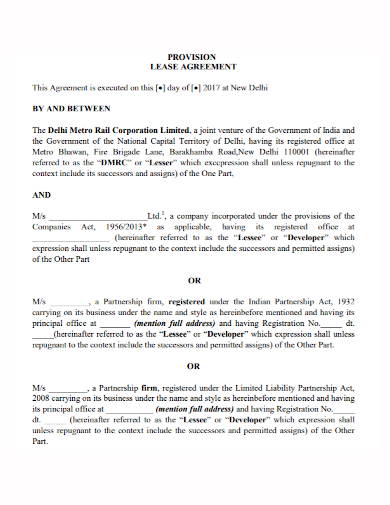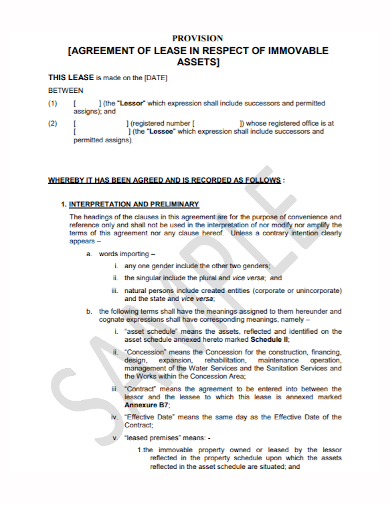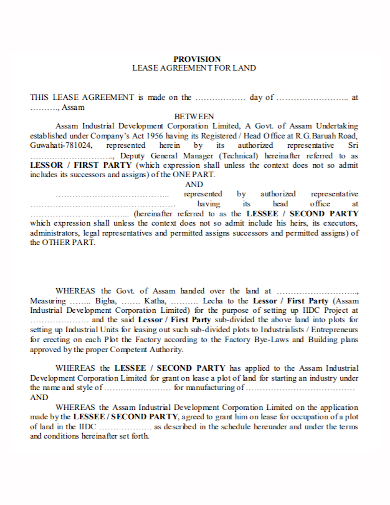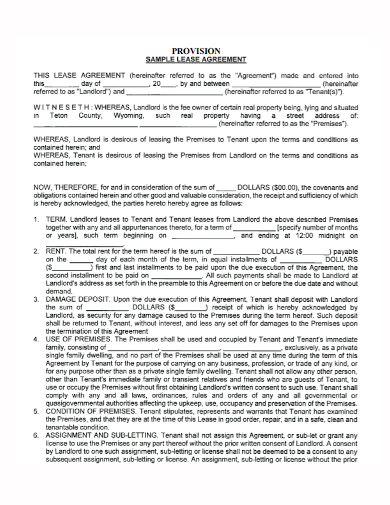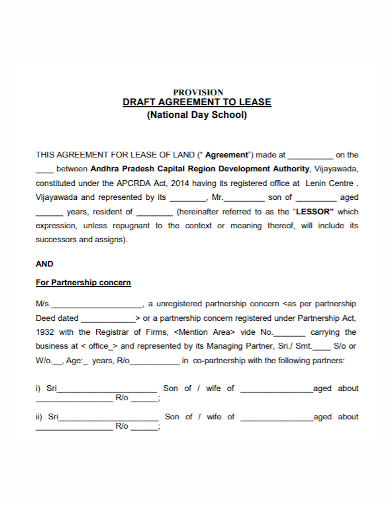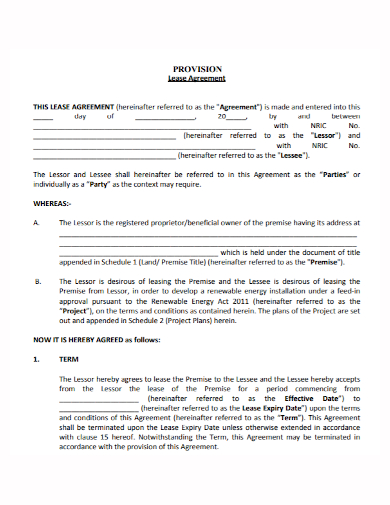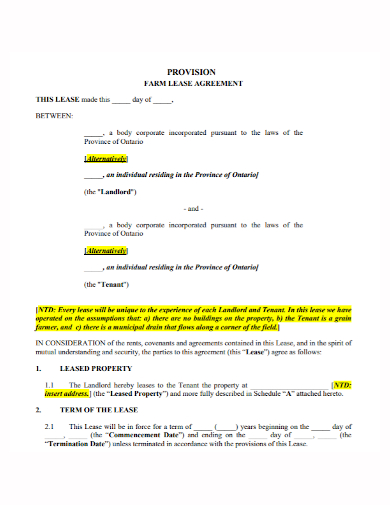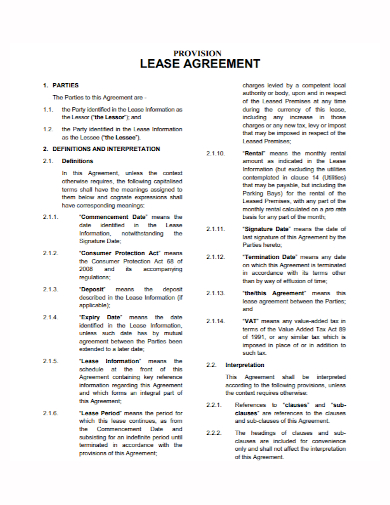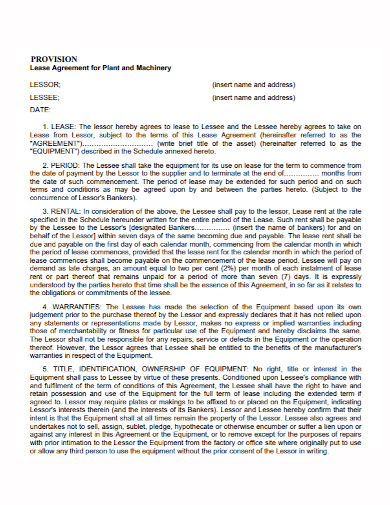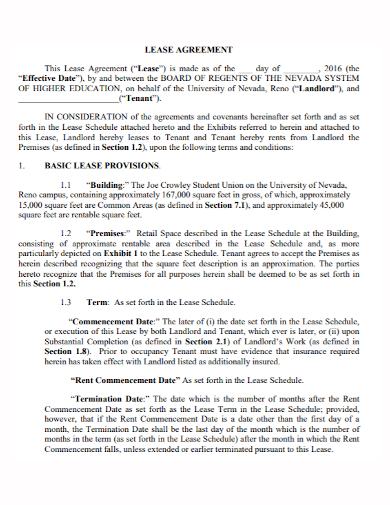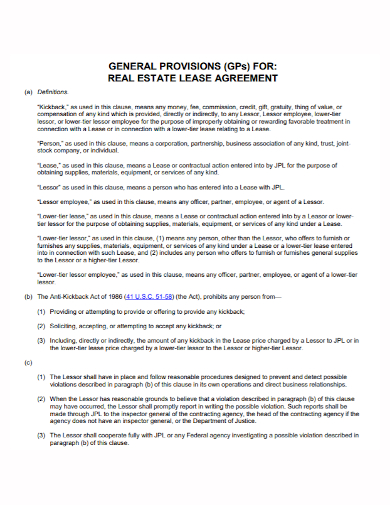Your lease or rental agreement could be one page long or ten pages long. It could be typed or handwritten, simple or complex, and full of legalese. Most landlords rely on preprinted forms that they can obtain from stationery stores, a landlords’ association, or a software program. A standard lease agreement is a legally binding contract between a tenant and a landlord that spells out each party’s responsibilities. The agreement may or may not include subtenants. It’s important to remember that rental agreements safeguard both the landlord and the tenant. As a result, the more comprehensive a lease agreement is, the less likely there will be misunderstandings — or legal disputes — during the term of the lease.
10+ Provision of Lease Agreement Samples
Because you’re bound by each provision of your lease agreement unless it’s unenforceable, it’s critical to know what you’re signing before you sign. Because many leases use standard language, lease provisions are commonly referred to as “boilerplate.” The terms of the lease, payment dates, and late fees are all examples of boilerplate language in a lease.
1. Corporation Provision of Lease Agreement
2. Provision of Immovable Lease Agreement
3. Provision of Land Lease Agreement
4. Provision of Lease Agreement
5. Provision of School Lease Agreement
6. Sample Provision of Lease Agreement
7. Provision of Farm Lease Agreement
8. Standard Provision of Lease Agreement
9. Provision of Plant and Machinery Lease Agreement
10. Basic Provision of Lease Agreement
11. Provision of Real Estate Lease Agreement
Residential Lease Provision
Every written residential lease that involves property used as a home should include some basic but essential information. The lease will list the tenant and landlord, as well as the property’s address. The lease’s term or duration will be included. The monthly rent, the date the rent is due, the late fees, and any required security deposit should all be included in the lease.
In addition, the lease divides duties between the landlord and the tenant. It will determine whether the tenant or the landlord is liable for utilities such as gas, electricity, and garbage collection. If you’re a tenant, you should be aware of the repairs and maintenance that you’ll be responsible for.
In most cases, a residential lease will limit how tenants can use the property. The occupants of the apartment may be limited to those who have signed the lease and their minor children. It may also limit the number of guests who can stay at the property and the length of their stay. Many leases place restrictions on the types of pets that a tenant may have, and some even prohibit pets entirely. Some leases may state that no type of business can be conducted on the premises. Painting, wallpapering, changing flooring, appliances, cabinetry, and other changes to the property are typically prohibited by residential leases. In fact, the landlord can impose almost any restriction on the tenant as long as the restrictions do not violate federal or state law.
Commercial Lease Provision
A commercial lease is simply a lease for business-related real estate. Commercial leases are more complicated than residential leases, but they share many of the same provisions. Both the landlord and the tenant will be named. If you’re only leasing a portion of a building, such as a space in an indoor mall or office building, the address and specific part of the building will be identified. You’ll see a term clause that specifies the lease’s duration. There are also clauses addressing communication and notice, inspection, dispute resolution, and lease termination conditions.
While some aspects of a commercial lease will be similar to those of a residential lease, others will be sufficiently different to warrant discussion. A commercial lease will cover security deposits and rent, but rent for commercial tenants is frequently different from that of residential tenants. Gross leases, net leases, double net leases, and triple net leases are examples of commercial leases. A gross lease is similar to paying rent for a home, in that you only pay the rent and the landlord handles the insurance, taxes, and maintenance. You pay rent and your share of the property taxes in a net lease. You may rent as well as your share of taxes and insurance in a double net lease. You must also pay maintenance costs under a triple net lease.
FAQs
What are the unenforceable lease clauses?
- Agreements that the landlord has the right to repossess the property if the tenant defaults on the rent – In most cases, the landlord will be required to follow standard eviction procedures, which are governed by state and local laws.
- Agreements that allow the landlord to enter the rental unit at any time (without notice) – This is a violation of the tenant’s right to reasonable privacy.
- Agreements that tenants will pay for all damages to the rental unit regardless of fault – It would be unjust for a landlord to charge a tenant for damage that would have occurred regardless of fault.
- Agreements that court action will entitle the landlord to more money than the court can order
What is the “term of the tenancy” means?
The term refers to the length of the rental agreement. The beginning date and whether the tenancy is month-to-month or a lease should be included in the document. If it’s a lease, the end date should be included as well. One-year leases are very common. The primary difference between a lease and a rental agreement is usually the term of the tenancy, and the landlord usually makes the decision.
If you want to see more samples and formats, check out some provisions of lease agreement samples and templates provided in the article for your reference.
Related Posts
FREE 10+ Mentoring Agreement Samples In MS Word | Apple Pages | PDF
FREE 10+ Partner Agreement Samples In MS Word | Google Docs | Apple Pages | PDF
FREE 10+ Individual Agreement Samples In MS Word | Google Docs | Apple Pages | PDF
FREE 10+ Strategic Agreement Samples In MS Word | Google Docs | Apple Pages | PDF
FREE 10+ Equity Agreement Samples In MS Word | Google Docs | Apple Pages | PDF
FREE 10+ Producer Agreement Samples in MS Word | Apple Pages | PDF
FREE 10+ Grant Agreement Samples In MS Word | Apple Pages | PDF
FREE 8+ Meeting Agreement Samples in MS Word | Google Docs | Apple Pages | PDF
FREE 10+ Community Agreement Samples In MS Word | Google Docs | PDF
FREE 8+ Real Estate Option Agreement Samples in MS Word | PDF
FREE 10+ Call Option Agreement Samples In MS Word | PDF
FREE 10+ Advertising Agreement Samples In MS Word | Google Docs | Apple Pages | PDF
FREE 10+ Car Agreement Samples In MS Word | Google Docs | Apple Pages | PDF
FREE 10+ Horse Agreement Samples In MS Word | Apple Pages | PDF
FREE 10+ Option Agreement Samples In MS Word | Google Docs | Apple Pages | PDF

